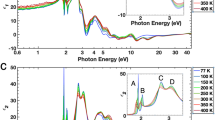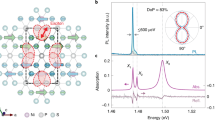Abstract
A longitudinal field component parallel to the wave vector is generally considered in nonlocal optical response. Longitudinal volume plasmons accompanied by inhomogeneous internal field optically break symmetry for isotropic metal nanoparticles. Here, natural circular dichroism in the interband transitions of TiN nanocubes, Au nanospheres, and Cu nanospheres in solution is presented. A field gradient or volume plasmons exert an electric force and consequently Lorentz force on bound valence-band electrons inside the nanoparticles. It is generalized that interband transitions in nanoparticles intrinsically produce a positive rotational strength and optical right-handedness. Electromechanical chir-alty is introduced to explain the optical activity of achiral nanoparticles.





Similar content being viewed by others
References
G.H. Wagniere: On Chirality and the Universal Asymmetry (VHCA & Wiley-VCH, Zurich, 2007).
M.V. Mukhina, V.G. Maslov, A.V. Baranov, A.V. Fedorov, A.O. Orlova, F. Purcell-Milton, J. Govan, and Y.K. Gun’ko: Intrinsic chirality of CdSe/ ZnS quantum dots and quantum rods. Nano Lett. 15, 2844 (2015).
T. Okuda, and A. Kimura: Spin- and angle-resolved photoemission of strongly spin-orbit coupled systems. J. Phys. Soc. Jpn. 82, 021002 (2013).
C.F. Bohren: Light scattering by an optically active sphere. Chem. Phys. Lett. 29, 458 (1974).
J.-W. Park: Observation of intrinsic chirality of surface plasmon resonances in single nanocrystals. arXiv:1803.00547 [cond-mat.mes-hall].
J.J. Hopfield, and D.G. Thomas: Theoretical and experimental effects of spatial dispersion on the optical properties of crystals. Phys. Rev. 132, 563 (1963).
S. Shokhovets, O. Ambacher, B.K. Meyer, and G. Gobsch: Anisotropy of the momentum matrix element, dichroism, and conduction-band dispersion relation of wurtzite semiconductors. Phys. Rev. B 78, 035207 (2008).
V.P. Mineev, and Yu. Yoshioka: Optical activity of noncentrosymmetric metals. Phys. Rev. B 81, 094525 (2010).
V.M. Agranovich, and V.L. Ginzburg: Spatial Dispersion in Crystal Optics and the Theory of Excitons (Interscience Publishers, London, 1966).
S.F. Mason: Molecular Optical Activity and the Chiral Discriminations (Cambridge Univ. Press, Cambridge, 1982).
G.M. Wysin, V. Chikan, N. Young, and R.K. Dani: Effects of interband transitions on Faraday rotation in metallic nanoparticles. J. Phys: Condens. Matter 25, 325302 (2013).
R.P. Cameron, J.B. Götte, S.M. Barnett, and A.M. Yao: Chirality and the angular momentum of light. Phil. Trans. R. Soc. A 375, 20150433 (2017).
W. Kuhn: The physical significance of optical rotatory power. Trans. Faraday Soc. 26, 293 (1930).
A.Ya. Bekshaev, O.V. Angelsky, S.G. Hanson, and C.Yu. Zenkova: Scattering of inhomogeneous circularly polarized optical field and mechanical manifestation of the internal energy flows. Phys. Rev. A 86, 023847 (2012).
L.T. Vuong, A.J.L. Adam, J.M. Brok, P.C.M. Planken, and H.P. Urbach: Electromagnetic spin-orbit interactions via scattering of subwavelength apertures. Phys. Rev. Lett. 104, 083903 (2010).
M. Kang, Q.-H. Guo, J. Chen, B. Gu, Y. Li, and H.-T. Wang: Near-field phase singularity in subwavelength metallic microstructures. Phys. Rev. A 84, 045803 (2011).
P.F. Chimento, P.F.A. Alkemade, G.W.’ t Hooft, and E.R. Eliel: Optical angular momentum conversion in a nanoslit. Opt. Lett. 37, 4946 (2012).
Z.B. Wang, B.S. Luk’yanchuk, M.H. Hong, Y. Lin, and T.C. Chong: Energy flow around a small particle investigated by classical Mie theory. Phys. flei 70, 035418 (2004).
A. Aid, and N. Engheta: Higher-order resonant power flow inside and around superdirective plasmonic nanoparticles. J. Opt. Soc. Am. B 24, A89 (2007).
G.F. Quinteiro, F. Schmidt-Kaler, and C.T. Schmiegelow: Twisted-light-ion interaction: the role of longitudinal fields. Phys. Rev. Lett. 119, 253203 (2017).
A. Afanasev, C.E. Carlson, and M. Solyanik: Circular dichroism of twisted photons in non-chiral atomic matter. J. Opt. 19, 105401 (2017).
N.D. Singh, M. Moocarme, B. Edelstein, N. Punnoose, and L.T. Vuong: Anomalously-large photo-induced magnetic response of metallic nano-colloids in aqueous solution using a solar simulator. Opt. Express 20, 19214 (2012).
R. Hertel: Theory of the inverse Faraday effect in metals. J. Magn. Magn. Mater. 303, L1–L4 (2006).
R. Hertel, and M. Fannie: Macroscopic drift current in the inverse Faraday effect. Phys. Rev. B 91, 020411 (R) (2015).
J.M. McMahon, S.K. Gray, and G.C. Schatz: Nonlocal optical response of metal nanostructures with arbitrary shape. Phys. Rev. Lett. 103, 097403 (2009).
S. Adachi, and M. Takahashi: Optical properties of TiN films deposited by direct current reactive sputtering. J. Appl. Phys. 87, 1264 (2000).
Y. Gu, and K.G. Kornev: Plasmon enhanced direct and inverse Faraday effects in non-magnetic nanocomposites. J. Opt. Soc. Am. B 27, 2165 (2010).
M. Durach, and N. Noginova: Spin angular momentum transfer and plasmogalvanic phenomena. Phys. Rev. B 96, 195411 (2017).
H. Kontani, T. Tanaka, D.S. Hirashima, K. Yamada, and J. Inoue: Giant orbital hall effect in transition metals: origin of large spin and anomalous hall effects. Phys. Rev. Lett. 102, 016601 (2009).
J. Van Bree, A.Yu. Silov, P.M. Koenraad, and M.E. Flatte: Spin-orbit-induced circulating currents in a semiconductor nanostructure. Phys. Rev. Lett. 112, 187201 (2014).
Author information
Authors and Affiliations
Corresponding author
Electronic supplementary material
43579_2018_8020459_MOESM1_ESM.pdf
Supplementary Material: Circular dichroism in the interband transitions of achiral metal nanoparticles: TiN and noble metals
Supplementary material
Supplementary material
The supplementary material for this article can be found at https://doi.org/10.1557/mrc.2018.40
Rights and permissions
About this article
Cite this article
Park, JW. Circular dichroism in the interband transitions of achiral metal nanoparticles: TiN and noble metals. MRS Communications 8, 459–465 (2018). https://doi.org/10.1557/mrc.2018.40
Received:
Accepted:
Published:
Issue Date:
DOI: https://doi.org/10.1557/mrc.2018.40




